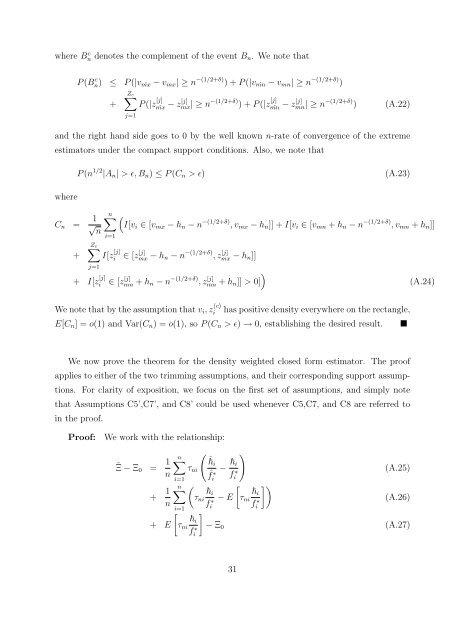weighted and two stage least squares estimation of ... - Boston College
weighted and two stage least squares estimation of ... - Boston College
weighted and two stage least squares estimation of ... - Boston College
You also want an ePaper? Increase the reach of your titles
YUMPU automatically turns print PDFs into web optimized ePapers that Google loves.
where B c n denotes the complement <strong>of</strong> the event Bn. We note that<br />
P (B c n) ≤ P (|vmx ˆ − vmx| ≥ n −(1/2+δ) ) + P (|vmn ˆ − vmn| ≥ n −(1/2+δ) )<br />
+<br />
Zc <br />
j=1<br />
P (|z [j]<br />
mx ˆ − z[j]<br />
mx| ≥ n −(1/2+δ) ) + P (|z [j]<br />
mn ˆ<br />
− z[j]<br />
mn| ≥ n −(1/2+δ) ) (A.22)<br />
<strong>and</strong> the right h<strong>and</strong> side goes to 0 by the well known n-rate <strong>of</strong> convergence <strong>of</strong> the extreme<br />
estimators under the compact support conditions. Also, we note that<br />
where<br />
P (n 1/2 |An| > ɛ, Bn) ≤ P (Cn > ɛ) (A.23)<br />
Cn = 1<br />
√ n<br />
+<br />
Zc <br />
j=1<br />
+ I[z [j]<br />
i<br />
n <br />
I[vi ∈ [vmx − hn − n −(1/2+δ) , vmx − hn]] + I[vi ∈ [vmn + hn − n −(1/2+δ) , vmn + hn]]<br />
i=1<br />
I[z [j]<br />
i<br />
∈ [z[j]<br />
mx − hn − n −(1/2+δ) , z [j]<br />
mx − hn]]<br />
∈ [z[j] mn + hn − n −(1/2+δ) , z [j]<br />
<br />
mn + hn]] > 0]<br />
We note that by the assumption that vi, z (c)<br />
i<br />
has positive density everywhere on the rectangle,<br />
E[Cn] = o(1) <strong>and</strong> Var(Cn) = o(1), so P (Cn > ɛ) → 0, establishing the desired result. <br />
We now prove the theorem for the density <strong>weighted</strong> closed form estimator. The pro<strong>of</strong><br />
applies to either <strong>of</strong> the <strong>two</strong> trimming assumptions, <strong>and</strong> their corresponding support assump-<br />
tions. For clarity <strong>of</strong> exposition, we focus on the first set <strong>of</strong> assumptions, <strong>and</strong> simply note<br />
that Assumptions C5’,C7’, <strong>and</strong> C8’ could be used whenever C5,C7, <strong>and</strong> C8 are referred to<br />
in the pro<strong>of</strong>.<br />
Pro<strong>of</strong>: We work with the relationship:<br />
ˆΞ − Ξ0 = 1<br />
n<br />
<br />
ˆi<br />
τni<br />
n ˆf i=1<br />
∗ −<br />
i<br />
i<br />
f ∗ <br />
i<br />
+ 1<br />
n<br />
<br />
i<br />
τni<br />
n f<br />
i=1<br />
∗ <br />
− E<br />
i<br />
<br />
i<br />
+ E<br />
τni<br />
f ∗ i<br />
− Ξ0<br />
31<br />
i<br />
τni<br />
f ∗ i<br />
<br />
(A.25)<br />
(A.26)<br />
(A.27)<br />
(A.24)

















